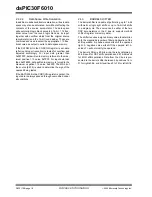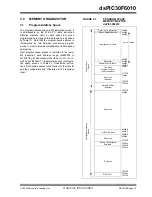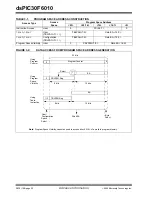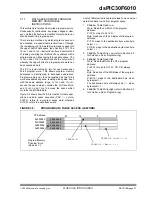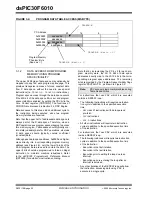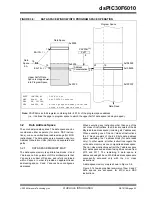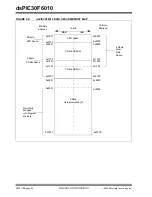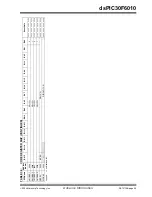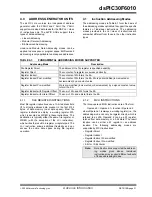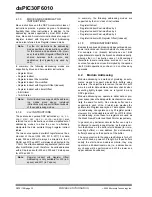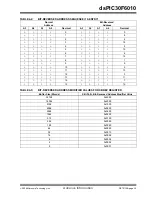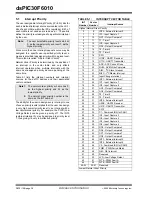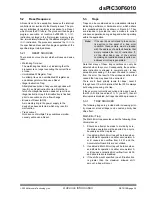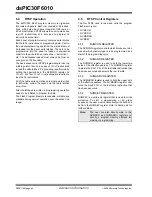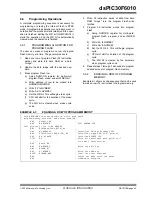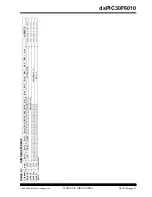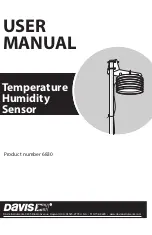
dsPIC30F6010
DS70119B-page 32
Advance Information
2004 Microchip Technology Inc.
4.1.3
MOVE AND ACCUMULATOR
INSTRUCTIONS
Move instructions and the DSP Accumulator class of
instructions provide a greater degree of addressing
flexibility than other instructions. In addition to the
addressing modes supported by most MCU instruc-
tions, Move and Accumulator instructions also support
Register Indirect with Register Offset Addressing
mode, also referred to as Register Indexed mode.
In summary, the following addressing modes are
supported by Move and Accumulator instructions:
• Register Direct
• Register Indirect
• Register Indirect Post-modified
• Register Indirect Pre-modified
• Register Indirect with Register Offset (Indexed)
• Register Indirect with Literal Offset
• 8-bit Literal
• 16-bit Literal
4.1.4
MAC
INSTRUCTIONS
The dual source operand DSP instructions (
CLR,
ED,
EDAC,
MAC,
MPY,
MPY.N,
MOVSAC
and
MSC
), also
referred to as
MAC
instructions, utilize a simplified set of
addressing modes to allow the user to effectively
manipulate the data pointers through register indirect
tables.
The two source operand pre-fetch registers must be a
member of the set {W8, W9, W10, W11}. For data
reads, W8 and W9 will always be directed to the X
RAGU and W10 and W11 will always be directed to the
Y AGU. The effective addresses generated (before and
after modification) must, therefore, be valid addresses
within X data space for W8 and W9 and Y data space
for W10 and W11.
In summary, the following addressing modes are
supported by the
MAC
class of instructions:
• Register Indirect
• Register Indirect Post-modified by 2
• Register Indirect Post-modified by 4
• Register Indirect Post-modified by 6
• Register Indirect with Register Offset (Indexed)
4.1.5
OTHER INSTRUCTIONS
Besides the various addressing modes outlined above,
some instructions use literal constants of various sizes.
For example,
BRA
(branch) instructions use 16-bit
signed literals to specify the branch destination directly,
whereas the
DISI
instruction uses a 14-bit unsigned
literal field. In some instructions, such as
ADD
Acc
, the
source of an operand or result is implied by the opcode
itself. Certain operations, such as
NOP
, do not have any
operands.
4.2
Modulo Addressing
Modulo addressing is a method of providing an auto-
mated means to support circular data buffers using
hardware. The objective is to remove the need for soft-
ware to perform data address boundary checks when
executing tightly looped code, as is typical in many
DSP algorithms.
Modulo addressing can operate in either data or pro-
gram space (since the data pointer mechanism is essen-
tially the same for both). One circular buffer can be
supported in each of the X (which also provides the
pointers into Program space) and Y data spaces. Mod-
ulo addressing can operate on any W register pointer.
However, it is not advisable to use W14 or W15 for Mod-
ulo addressing, since these two registers are used as
the Stack Frame Pointer and Stack Pointer, respectively.
In general, any particular circular buffer can only be
configured to operate in one direction, as there are cer-
tain restrictions on the buffer start address (for incre-
menting buffers) or end address (for decrementing
buffers) based upon the direction of the buffer.
The only exception to the usage restrictions is for buff-
ers which have a power-of-2 length. As these buffers
satisfy the start and end address criteria, they may
operate in a Bi-directional mode, (i.e., address bound-
ary checks will be performed on both the lower and
upper address boundaries).
Note:
For the
MOV
instructions, the addressing
mode specified in the instruction can differ
for the source and destination EA. How-
ever, the 4-bit Wb (Register Offset) field is
shared between both source and
destination (but typically only used by
one).
Note:
Not all instructions support all the address-
ing modes given above. Individual
instructions may support different subsets
of these addressing modes.
Note:
Register Indirect with Register Offset
Addressing is only available for W9 (in X
space) and W11 (in Y space).
Summary of Contents for dsPIC30F6010
Page 12: ...dsPIC30F6010 DS70119B page 10 Advance Information 2004 Microchip Technology Inc NOTES...
Page 32: ...dsPIC30F6010 DS70119B page 30 Advance Information 2004 Microchip Technology Inc NOTES...
Page 38: ...dsPIC30F6010 DS70119B page 36 Advance Information 2004 Microchip Technology Inc NOTES...
Page 50: ...dsPIC30F6010 DS70119B page 48 Advance Information 2004 Microchip Technology Inc NOTES...
Page 68: ...dsPIC30F6010 DS70119B page 66 Advance Information 2004 Microchip Technology Inc NOTES...
Page 72: ...dsPIC30F6010 DS70119B page 70 Advance Information 2004 Microchip Technology Inc NOTES...
Page 76: ...dsPIC30F6010 DS70119B page 74 Advance Information 2004 Microchip Technology Inc NOTES...
Page 86: ...dsPIC30F6010 DS70119B page 84 Advance Information 2004 Microchip Technology Inc NOTES...
Page 108: ...dsPIC30F6010 DS70119B page 106 Advance Information 2004 Microchip Technology Inc NOTES...
Page 116: ...dsPIC30F6010 DS70119B page 114 Advance Information 2004 Microchip Technology Inc NOTES...
Page 128: ...dsPIC30F6010 DS70119B page 126 Advance Information 2004 Microchip Technology Inc NOTES...
Page 150: ...dsPIC30F6010 DS70119B page 148 Advance Information 2004 Microchip Technology Inc NOTES...
Page 164: ...dsPIC30F6010 DS70119B page 162 Advance Information 2004 Microchip Technology Inc NOTES...
Page 208: ...dsPIC30F6010 DS70119B page 206 Advance Information 2004 Microchip Technology Inc NOTES...
Page 220: ...dsPIC30F6010 DS70119B page 220 Advance Information 2004 Microchip Technology Inc NOTES...
Page 221: ...2004 Microchip Technology Inc Advance Information DS70119B page 221 dsPIC30F6010 NOTES...

